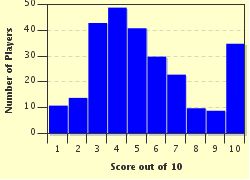Quiz Answer Key and Fun Facts
1. What is the A1 antigen?
2. What is the structure forming the antigen(s) of the Indian blood group system?
3. After the ABO blood group system, what is the second most clinically significant antigen system?
4. What is the antigen missing in persons with the Bombay phenotype?
5. Which two red cell antigens are not formed as part of the red cell membrane?
6. What is an ABO blood group subtype?
7. Where did the name of the name of the Duffy blood group system come from?
8. What is one mechanism for the acquired B phenotype?
9. Which red cell antigen is the receptor for the malarial parasite Plasmodium vivax?
10. Which red cell antigen is missing or shows very weak expression in McLeod syndrome?
Source: Author
lateonenite
This quiz was reviewed by FunTrivia editor
crisw before going online.
Any errors found in FunTrivia content are routinely corrected through our feedback system.


